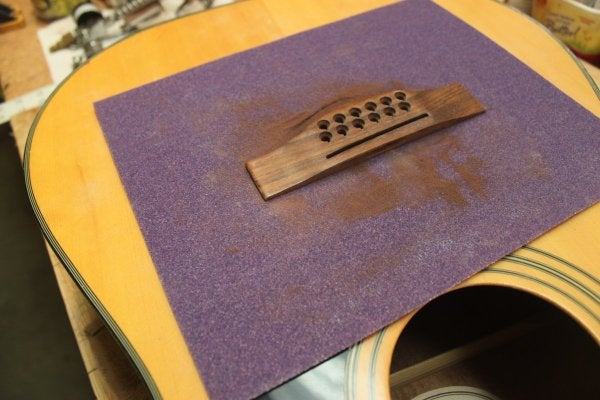I have been learning how to repair guitars and a teacher friend brought this to me to fix for a student. My goal on repairs is find guitars, fix them up and give them to people who may not be able to afford one. Obviously, I am not working on Martins but perhaps one day I will be brave enough to do so.
This guitar is something I have not run into. Although I have done several bridge repairs, I have not seen it where the bridge looks like it bent the top of the sound board. The guitar is a mahogany (laminate) Tanglewood Crossroads TWCRP that the student uses. The people tried to glue it in and when it pulled out again, I was given the chance to fix it. I forgot to take some pictures of what it looked like before. There were chunks missing.
Below are two pictures of where I am at currently. In each photo the gaps are easy to see. The bridge seems to be sitting on a bulge that makes me think it has been deformed. I would love to fix this because it is something different. My initial thought is to sand down the top but I worry about weakening the structure. When I look at the underside of the bridge plate, it appears fine, no gaps.
I am not experienced enough to convince myself that if I glue it on (after proper cleanup) like I have done in the past that this will hold right and there won’t be any gaps. If someone in the group has run into something like this and has any insight they could share, it would be greatly appreciated. I have read through threads by Freeman, Guitarbuilder and 1bad914 but nothing like this.
Thanks in advance if you can point me to a path of getting this fixed.


This guitar is something I have not run into. Although I have done several bridge repairs, I have not seen it where the bridge looks like it bent the top of the sound board. The guitar is a mahogany (laminate) Tanglewood Crossroads TWCRP that the student uses. The people tried to glue it in and when it pulled out again, I was given the chance to fix it. I forgot to take some pictures of what it looked like before. There were chunks missing.
Below are two pictures of where I am at currently. In each photo the gaps are easy to see. The bridge seems to be sitting on a bulge that makes me think it has been deformed. I would love to fix this because it is something different. My initial thought is to sand down the top but I worry about weakening the structure. When I look at the underside of the bridge plate, it appears fine, no gaps.
I am not experienced enough to convince myself that if I glue it on (after proper cleanup) like I have done in the past that this will hold right and there won’t be any gaps. If someone in the group has run into something like this and has any insight they could share, it would be greatly appreciated. I have read through threads by Freeman, Guitarbuilder and 1bad914 but nothing like this.
Thanks in advance if you can point me to a path of getting this fixed.




